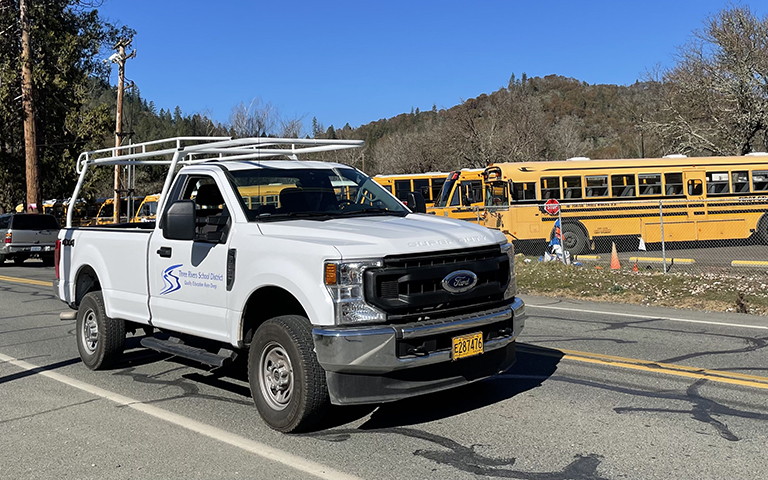READ THE FULL STORY
How can your organization duplicate these incredible results?
Get details on how Three Rivers School District:
- accomplished its goals
- saved thousands of dollars
- reinvested in education by partnering with UScellular for wireless solutions.
“Fleet management” isn’t a term often associated with schools, but perhaps it should be based on the experiences of a rural district in southwest Oregon. Three Rivers School District is saving tens of thousands of dollars by using technology that better monitors and maintains its extensive fleet.
The K-12 district has 17 schools in a vast, remote area, making it imperative to manage its assets, such as the tractors, SUVs and sedans the staff uses to service the large-area district, plus activity vans used to transport students to after-school events.
“For us, the focus is resource management—maximizing our resources and having data that can really help inform decision-making,” said Rob Saunders, Three Rivers Director of Technology and Support Services.
Tracking a Need for Data
Although Three Rivers has been working with UScellular® for more than 15 years, they didn’t have a fleet management solution until 2020. Saunders said the initiative began with the need to better track mileage so that mechanics knew when it was time to service a vehicle.
“Our mechanics didn’t really know how far the vehicle had been driven. They might say, ‘OK, I can go check the odometer or I can rely on that staff member to let me know when it gets to this many miles’.” With an easy-to-install device, they can now proactively schedule service or inspections by time or mileage intervals, thus preventing expensive repairs resulting from neglect.
“Right there, that is saving our district money because we’re taking better care of our assets,” Saunders said.
The district also uses tracking to more efficiently collect data required to submit reports to the Oregon Department of Education.
“I don’t know that there’s a lot of districts that are doing (fleet management). I would really like to expand that so any time a student is taking a trip for a sports team or a club, that they have connectivity during that trip.”
— Rob Saunders Director of Technology and Support Services, Three Rivers School District, Grants Pass, OR
Cost Savings through Fleet Data Tracking
The district uses GPS Trackit, powered by UScellular, to provide much-needed data that enables them to make informed decisions. Not only can they monitor 45 fleet vehicles equipped with the tracker, but the district can also use tracking to:
- plan more efficient travel routes and reduce fuel consumption
- help staff make behavioral changes that conserve energy
- reduce the manpower needed to locate vehicles
- increase safety by setting up alerts to monitor vehicle speeds
- get instant alerts if a stolen vehicle leaves a defined area

Three Rivers School District buses through thousands of miles of beautiful country roads.
“If we can better manage our resources in the fleet… if we’re able to save money, that goes back to the classroom,” Saunders said. Money saved is reinvested in student education and programs.
In addition, automated billing eliminates delays, so they no longer miss out on reimbursements. “It’s helped us financially to get our bills out, especially to the insurance companies. We definitely increased the amount of money received by at least $50,000-$100,000 annually.”
The other advantage is safety. “We have students on a trip and the driver knows that they have to drive no faster than 55mph,” said Saunders. “Well, now there is an alert sent to the principal that this van is exceeding that speed limit. So, I think there’s increased safety for especially those vehicles that the students are transported in.”
The benefits don’t stop there. Saunders and his team can use tracking to locate stolen assets, plus monitor excessive vehicle idling that consumes fuel.
“It’s cold in the morning, staff start up their vehicles and they’re idling. Well, it’s going to be a lot better use of resources if you just grab the ice scraper, scrape off the ice, start it up and maybe let it run for a few minutes and not let it sit there for 30 minutes while you’re getting your coffee, burning up fuel,” he said. “Just having data to help support us is changing some of those behaviors.”
The district also uses tracking to analyze travel routes and reduce fuel consumption by 15%. “We can see an employee has been taking this direction to get to this school every day, and through tracking, we realized that this route is three miles longer.” Multiply those three miles twice a day, every day, times dozens of workers. “They didn’t know that they could have saved three miles by going a different route, but now we have data and over time obviously that adds up,” Saunders said.
Bringing the Internet to Students
Like many school districts, Three Rivers also uses hotspots and wireless routers to connect students to the internet. They installed Cradlepoint routers on their activity vans and, during the pandemic, would drive them to remote areas to connect students online. “We’d find a central place to drive the van, and then students would meet up with card tables and tents and were able to connect with their teachers. In some cases, we even parked those vehicles at houses for students that needed Internet.
“You may have a household with three or four students attending schools, and with that router, they could all get online and still have the functionality that they need to learn. We have 500+ families that either have minimal connectivity where they really can’t do anything, or no connectivity at all,” Saunders said.
Responding More Efficiently to Maintenance and Security
Saunders says his district has worked with UScellular for more than 15 years, with the recent addition of providing iPhones for staff. “Those smart phones were really a huge shift for us. They had data plans, Wi-Fi, email and instant messaging. Staff can open our ticket system and take pictures of an issue in a building, and when the maintenance crew arrives, they don’t have to track down somebody to get the information,” he said.
He added that staff in certain departments such as maintenance and custodial use district-owned smart phones while administrators and tech staff instead receive a stipend to use their personal devices.
Needs for the Future
With the successful implementation of fleet management, the district is eying additional technologies. “We’ve talked about security systems and having cellular access,” he said. To that end, the district is trying to eliminate landlines and old analog lines and use just UScellular-capable units to drive security.
“My role in the district and my focus has really been innovation. I’m the director of technology, but I look at my role as trying to reach out and identify areas in which we can enhance our current systems. In some other areas I feel like we’re ahead—like fleet management. I don’t know that there’s a lot of districts that are doing that. I would really like to expand that so any time a student is taking a trip for a sports team or a club, that they have connectivity during that trip. Some of our bus rides are lengthy,” Saunders said.
The UScellular Difference
Saunders credits the personal relationship he has with his UScellular account manager, Garrett Schuster, for the program’s success. “Garrett and I have a relationship where we can bounce ideas off each other, or I can ask him, ‘Hey, we’re looking looking for a solution for X’ and then he’ll say, ‘I have something. Let’s, check this out,’ and he’ll do some digging. I think that relationship lends itself to collaboration and coming up with solutions to meet our needs,” he said.
Saunders chose UScellular for fleet management because he was satisfied with the cellular company’s service and preferred to use a single vendor rather than deal with multiple companies.
“Our relationship with UScellular has been pretty long-term and we’ve added solutions that have worked well for us. Garrett is really proactive in bringing us ideas. That’s how we started with GPS Trackit,” Saunders said.

Students work on technology partially paid for by saving through fleet management.
The feeling is mutual. Schuster said that Saunders is a tech director who asks questions and is always looking for cost savings. “Rob’s pretty good about doing account reviews and a lot of times there could be cost savings that he’s able to reinvest to better the school district. He looks for ways to leverage what UScellular is offering to reduce expenses and reinvest those cost savings into new technologies,” Schuster said.
“In our geography, UScellular has had the coverage that we’ve needed to serve our connectivity,” Saunders added. “There are other providers, of course, but if we shifted to a different carrier, we wouldn’t see the same connectivity.”
Saunders has noticed that while using a different cellular provider, there were locations that had minimal connectivity. With that other carrier, “I might be able to make a phone call, but I can’t access data. That’s a big deal when we have staff driving around between buildings and maybe they need to pull over and look something up in their phone or pull up a ticket.”
Undeniable Results
Saunders estimates that the school district has saved tens of thousands of dollars by implementing fleet management, with 15% fuel savings from mapping more direct routes and a 35% reduction in idle time. “Our vehicles are out there driving all over the place, and management is key. As we gather data, I think we could do even better. We’re really just scratching the surface of fleet management at this point, but it’s pretty exciting and we’re definitely happy with just the functionality of it and it is cost effective—it’s worth it.”












